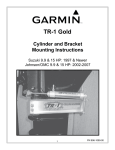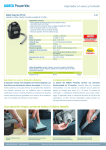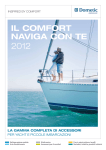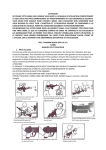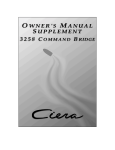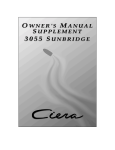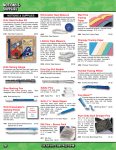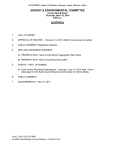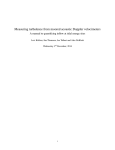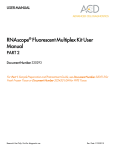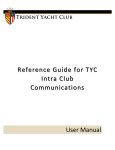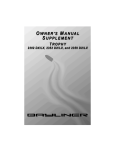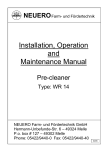Download Preventative Maintenance
Transcript
Updated 12/10/14 SAN JUAN YACHTING ANNUAL PREVENTIVE MAINTENANCE SCHEDULE FOR 2015 SEASON Responsibilities: The Maintenance Pro (MP) will contact the Boat Owner (O) so the O can decide who does what, after which the MP will circle the “M” or the “O” by each task AND deliver the PMS to Fleet Manager (Tim Hoving) who will stamp the ORIGINAL of this checklist with “Official Working Copy” (in red). Then the MP will place it in the Charter Guest Reference Notebook (at the back end of the 3-ring binder). As each task is completed, the person completing the task will initial & date the “Official Working Copy” onboard the vessel. OPTIONAL (but not recommended, so consult with your maintenance pro): Owners may opt for haulout once each 18 months or 24 months. For 24 month haulouts, the criteria listed on the top of the Haulout Checklist must be met. This is an experiment to determine if we can reduce costs while still maintaining quality and safety. As such, this procedure is subject to immediate revocation. IMPORTANT: Boat Owners and their MPs are responsible to keep this “Official Working Copy” (onboard the vessel) up to date with initials & dates as they accomplish tasks. For Charter-Ready Certification: Vessels are eligible for charter only when 100% of the “essential” Spring tasks are completed, initialed & dated. Items with a “+” are required but not “essential” and may be pushed beyond CharterFest, but must be accomplished prior to June 1. When all “essential” tasks are complete the MP will bring this schedule to General Manager Rick Sale for review and certification. Once certified by Rick’s initials here ________, the MP will place it back on the boat. Boat Name: _______________________________ FALL 2014: Maintenance Pro:_____________________________ Complete no later than December 31, 2014 (or earlier for freeze damage control) all required tasks below: 1. O or SJS Date & Initial: ______________ Add green (always on), yellow (“on” only when needed) and red (never touch) “dot” labels by all circuit breaker switches. 2. M O Date & Initial: ______________ Apply two coats varnish/Cetol/polyurethane to exterior teak. Renew areas as necessary. (Starting in September, look for first good weather window and schedule break.) 3. M O Date & Initial: ______________ Thoroughly clean bilge (all compartments). Consider using enzymeaction cleaners. (After season, vinegar is inadequate to reduce odors that build up in bilge.) 4. M O Date & Initial: ______________ Check ports and hatches for leaks. Reseal where necessary. Clean and coat opening port and hatch gaskets with talcum powder. 5. M O Date & Initial: ______________ Ensure cabin is properly vented, heater(s) set properly, cushions lifted or removed, drawers/doors open for ventilation to prevent mildew. 6. M O Date & Initial: ______________ Check smooth operation of the Y-valve(s). If any are stiff, notify Maintenance Pro to lubricate or replace. Page 1 of 12 Updated 12/10/14 7. M O Date & Initial: ______________ Before first predicted freeze, drain fresh water tanks, scrub interior (if accessible) to remove algae; rinse and treat with bleach solution to prevent algae build-up. Next day, drain to prevent freezing. 8. M O Date & Initial: ______________ Before first predicted freeze, check antifreeze level and freezing point in engine(s), genset (if applicable) and diesel furnace hot water cabin heat system (if applicable). Add protection if necessary. Test with PH test strips (bought in bulk from Owners Consumables Fund), and add corrosion inhibitor to heating system and/or engine(s) as necessary. 9. M O Date & Initial: ______________ Before first predicted freeze, close all seacocks below waterline except engine(s) and genset (s) for winter months to minimize danger of seacock, pipe and hose freezing. 10. M O Date & Initial: ______________ Before first predicted freeze, open all compartments, cupboard doors, below-deck entry doors and secure open or “tape open” (with painters tape) to assure good ventilation and distribution of heat (from space heater and ventilators). 11. M O Date & Initial: ______________ Before first predicted freeze, drain water from all faucets INCLUDING swim step shower’s faucet. 12. M O Date & Initial: ______________ After flushing holding tank(s) thoroughly, add prescribed amount of “No Flex Digester” (follow directions on container) into toilet and pump 20 times on wet-bowl setting so solution reaches holding tank. This will foster bacterial growth to eliminate “fecal lard” build up in the bottom of the holding tank(s). Then pump on dry-bowl setting to clear toilet of all standing water. Add RV antifreeze and flush on dry-bowl setting to flush solution into toilet fixture(s) 13. M O Date & Initial: ______________ Test the electric and manual bilge pumps to ensure they pump water. (Rebuild/replace if necessary.) Protect manual pump(s) from freezing. (Check to make sure there is one independent bilge pump on a float switch and “hot wired” to the house bank. If not, install.) 14. M O Date & Initial: ______________ Before first predicted freeze, “pickle” water maker (if applicable). 15. M O Date & Initial: ______________ Check battery voltages (with charger “off”) and, on unsealed batteries, the water level. Load test all batteries more than one year old to confirm they still have capacity, replace if necessary. Assure all connections are tight and coated with silicone grease. Turn charger back “on”. 16. M O Date & Initial: ______________ Put hand on shorepower/boat connection. If warm, find source of heat buildup. Check shorepower cord connection (male end, at dock box) for signs of black electrical arcing on prongs or prong holes. If present, cord has a short inside…replace! If okay, lubricate prongs at vessel’s electrical receptacle and at end of cord with dielectric silicon grease and re-plug into boat and dock box. (Turn dock box power breaker “on” and vessel’s charger breaker “on”.) 17. M O Date & Initial: ______________ Check seals / O-rings on deck filler caps. If deteriorated, repair to prevent leaks (especially water into diesel tanks and contamination into fresh water tanks). Lubricate with NSF-approved SUPER LUBE. 18. M O Date & Initial: ______________ Replace all raw water impellers on main engine(s) and genset (if applicable). NOTE: For Volvo and Perkins diesels, replace every 200 hours. 19. M O Date & Initial: ______________ Replace primary fuel filter (2 micron) on engine(s) and the genset, bleed fuel system and assure no air locks, test for proper operation and no leaks. 20. M O Date & Initial: ______________ Check belts for tension (1/2 inch deflection) and wear (look for black powder and cracks in belts). Adjust or replace. 21. HIGHLY RECOMMENDED (BUT OPTIONAL): M O Date & Initial: ______________ No one. Pick up oil sample kit from NAPA (best price). Take oil samples (old oil, before change) from main engine, transmission, and genset (if applicable) and submit to testing service for analysis and recording in oil sample log. Report any problems to owner and SJY. Page 2 of 12 Updated 12/10/14 22. M O Date & Initial: ______________/engine hrs:___________ If not changed for past 12 months, change (recommend Delo 400 15/40) in engine(s) and in genset (if applicable). 23. M O Date & Initial: _____________/engine hrs:_____________ Change transmission fluid. IMPORTANT NOTE: Check with engine manual to be sure the proper transmission fluid is used for individual makes/models. 24. M O Date & Initial: ______________ Check all bolts, screws, hose clamps, engine fittings for tightness. 25. M O Date & Initial: ______________ Check hoses for wear (i.e., chafe, cracking, swelling and general deterioration). Replace as necessary. Add chafe guards as necessary. 26. M O Date & Initial: ______________ Wipe engine(s) and mechanical components in engine room with oily cloth to remove dirt and grease (use degreaser if necessary). Remove any rust, spot paint engine(s) and other components if necessary for “like new” appearance. Coat engine(s) with WD-40 or BOE SHIELD anti-corrosion spray. 27. M O Date & Initial: ______________ At end of season, make sure fuel tanks are full. Add STANADYNE (1 oz per 4 gallons) and Racor Biocide (1 oz per 40 gallons “shock”, per 80 gallons maintenance). 28. M O Date & Initial: ______________ 1) Remove floorboards or inflatable floor from inflatable dinghy, if applicable. Thoroughly wash sand/rocks from inside hull. If wood floorboards/transom, check condition and, if needed, re-varnish or repaint each with PETTIT EZ-POXY paint (gray recommended). 2) If inflatable, re-insert floorboards and re-inflate dinghy, verify leak-free. (If dinghy leaks air, spray bottle of soapy water to find leak and repair.) 3) Clean with SUPER CLEAN (NOT acetone) or SEA POWER cleaner/wax. Protect with 303 AEROSPACE PROTECTANT or ISLAND GIRL protectant or FLEET WAX. 29. M O Date & Initial: ______________ Have outboard serviced/winterized by maintenance pro or an outboard professional. Empty gasoline from outboard tank. 30. M O Date & Initial: ______________ Inspect BBQ and replace any worn parts, remove from rail and stow in cockpit locker for winter protection. 31. M O Date & Initial: ______________ Lubricate and inspect anchor windlass. Check electrical connections and ground wire attachment bolt for tightness. 32. M O Date & Initial: ______________ Assure that there is a shackle between anchor and swivel connector to chain. Tighten shackle pin and secure with seizing wire, including on shackle at chain’s bitter end. Check that pin is secure on SS swivels that cannot be seized; if in doubt, re-bed with blue Loctite. 33. M O Date & Initial: ______________ Lubricate and inspect davit winches, service if necessary. Clean and lubricate davit rigging, make sure it is strong and safe. 34. M O Date & Initials: ______________ If flying bridge, remove and check exterior ignition control panel for water intrusion, loose wires and corrosion, spray with WD-40 or BOE SHIELD anti-corrosion spray to prevent corrosion/rust. 35. M O Date & Initials: ______________ Remove electrical control panel. Test all electrical connections for corrosion and tightness. Check all electrical connections for tightness/corrosion in bilge and in engine compartment and any other areas that may be close to water. 36. M O Date & Initial: ______________ Confirm all stanchions secure. Confirm rail gates, latches, swim ladder and securing mechanisms operate smoothly, lubricate. Tension any cables between stanchions as required for tightness and safety. Check stanchion cable fastener security. 37. M O Date & Initial: ______________ Renew interior varnish to “like new” varnished and/or oiled finish. Inspect bulkheads, tables, doors, steps and cabin sole. (Add an additional coat of varnish or polyurethane [inspect Polyurethane surfaces—may last more than one year] to heavy-traffic areas of your wooden sole annually.) 38. M O Date & Initial: ______________ Replace any non-skid on stairs if worn. Clear tape coated with varnish or Page 3 of 12 Updated 12/10/14 brown non-skid tape recommended. 39. M O Date & Initial: ______________ Renew painted finishes as necessary. 40. M O Date & Initial: ______________ Inventory tools in onboard tool box against SJY required Tool List. (See later in this document.) Purchase and/or replace tools as necessary. Wipe down all metal tools and parts with WD40. NOTE: Maintenance professional is required to confirm to SJY that all required tools are aboard. 41. M O Date & Initial: ______________ Every 5 years, replace non-PVC head system waste hoses. Use PVC pipe wherever possible, and top-quality thick-wall hose where necessary. If “premium” hose (e.g. Trident) is used, please change hose replacement interval to every 10 years. (Also, any lengths of PVC pipe can follow the every10-year replacement interval.) Use two stainless hose clamps on all hose connections. Note: Write on hose (inside a compartment, but visible when compartment is opened) with indelible marker both “hose installed (00/00)” AND “change on (00/00)” (5 or 10 years hence). 42. M O Date & Initial: ______________ Every 5 years, thoroughly service the diesel cabin heater. (Follow service manual.) Or subcontract task to authorized service technician or company. WEBASTO (use certified Webasto technician only): Forced Air System: Annually, inspect/replace filter, check lint/dust around cowling, check ducting, check exhaust and exhaust blanket. Test run for 1-2 hours. (In addition on odd numbered years, open unit, clean and inspect, evaluate seals.) Hydronic System: Annually, inspect/replace filter, check pH balance, check fans, check exhaust, quick air bleed, blow coils out, quick check combustion tube (clean as necessary). Test run for 2-4 hour. (In addition on odd numbered years, change fuel nozzle, change water conditioner filter, wipe photo eye clean, clean electrodes, pull combustion tube our and wire brush clean.) O Date & Initial: ___________ On all holding tanks, use 1" air vent hoses (replace fitting to larger 1" if 43. M necessary) to prevent overfill clogs (debris) in the vent hoses leading to “vacuum lock” which prevents/hinders holding tank discharge, and for odor abatement (microbes in tank need lots of oxygen). For through-hull, use stainless steel (Mfg# THMB1.000S by Marine Hardware). In most cases, leave the “clam shell” off. OPTIONAL: For better aeration for microbial action and odor reduction, install TWO 1” vent hoses per tank. O Date & Initial: ______________ Inventory spare engine parts against SJY required “Engine Spares” (see 44. M and check off list below). Purchase and/or replace engine spares as necessary. Place items in plastic (e.g., Sterilite) box labeled “Engine Spares”. NOTE: Maintenance professional is required to confirm to SJY that all required engine spares are aboard. 45. M O Date & Initial: ______________ Inventory general spare parts against SJY required “General Spares” (see and check off list below). Purchase and/or replace general spares as necessary. Place items in plastic (e.g., Sterilite) box labeled “General Spares”. NOTE: Maintenance professional is required to confirm to SJY that all required general spares are aboard. OWNERS: Location of general spares must be clearly indicated in Notes from Owner, under “S” for “Spares Parts”. (See next page for required tools and spares – check off that all are aboard) Page 4 of 12 Updated 12/10/14 Assembled in BOX with clear plastic cover labeled: “Engine Spares” Spare fuel filters for engine, generator (if applicable) Spare raw water filters for watermaker (if applicable) Spare belts for engine(s), and generator (if applicable) Spare impellers for engine and generator (if applicable) Impeller “puller” tool (needed on all boats) Spare impeller plate gaskets for each In a compartment (with location noted in you Owners Notes): 1 gallon spare oil for each engine – write “Main Engines Only” on containers 1 quart spare oil for generator (if applicable) – write “Generator Only” on container Quart transmission oil or fluid (check specific oil or fluid required by the specific transmission) – write “Transmission Only” on container 2 gallons of appropriate engine coolant (NOTE: Not automotive engine coolant.) 2 gallons of battery water (distilled) – write “for batteries” on container Replacement head pump (for manual pump toilets only) / plus a dozen pairs of surgical gloves OR If you have a VacuFlush head, 4 duckbill valves per toilet plus on bowl seal and one ball valve assembly. Assembled in box with clear plastic cover labeled: “Propeller Spares” Spare propeller(s) with prop nut assemblies, zincs, etc. Assembled in box with clear plastic cover labeled: “General Spares” Minimum of 2 spare light bulbs for each type of navigation and cabin lights To consume less power, recommend replacing halogen bulbs with L.E.D: Imtra – IMT ILBPG4-10c (“bright white” light for heads) and Imtra – IMT ILBPG4-10w (“warm while” light for all other areas) Minimum of a dozen 12-inch zip ties 2 hose clamps for each size fitting 6 cotter rings, various sizes (if vessel has lifelines) Various screws, nuts, bolts 2 spare lifeline pins – clevis pins Stainless seizing wire If applicable, assembled in BOX with clear plastic cover labeled: “Hydronic Heater Spares” Coolant conditioner filter Fuel Nozzle Photo eye Maintenance Professional (only) Date & Initial:_________________ Page 5 of 12 Updated 12/10/14 TOOLS (need both 1 and 2 below…or one tool box containing all of the items below) 1. Tool box or tool bag containing: 10 inch crescent wrench Channel locks One each: #1 and #2 slot (straight) and Philips head screw drivers (4 total screw drivers) Small hack saw (tungsten or carbon blade preferred) Vice grips (large) Can of McLube SailKote – non dirt/grit attracting spray lubrication (SJY bulk buy) Assortment of small nylon, stainless steel and bronze bushes Small metal file Roll duct tape Digital voltmeter (SJY bulk buy) 2. West Marine 133-piece tool set (SJY bulk buy). Contains: Open-end box wrenches: SAE 3/8”-5/8” Metric 10,12,13,14,15mm Socket wrenches: SAE 5/32”-1/2”x ¼” drive Metric 4-12mm ¼”x drive 3/8”-11/16”x 3/8” drive 9-17mm 3/8”x drive 5/8” & 13/16”x 3/8” drive spark plug sockets, ¼” adaptor 3/8” drive ratchet 6” adjustable crescent wrench 5”needle nose pliers (with wire cutter) 5” pliers Small needle nose pliers with built-in wire cutter Electrical crimping tool Small wire brush Small file #0 x 3” Philips screw driver Bit driver handles 1/8”-1/2”, assorted terminal ends Allen wrenches: SAE 1/16”-1/4” Metric 1.5-6mm Assorted driver bits including Philips, slot, hex and star (optional with the 4 screw drivers above) Maintenance Professional (only) Date & Initial:_________________ Page 6 of 12 Updated 12/10/14 “WINTER WATCH” & STORM CHECK ctober - April DURING AND AFTER STORMS: Complete 1-6 below. Date & Initial: ________ Date & Initial: ________ Date & Initial: ________ Date & Initial: ________ Date & Initial: ________ Date & Initial: ________ Date & Initial: ________ Date & Initial: ________ Date & Initial: ________ Date & Initial: ________ Date & Initial: ________ Date & Initial: ________ 1. M O Check bow, stern and spring lines for wear, alter/replace (add chafe guards) as needed. Recommend double bow lines for added holding in storms. 2. M O Check fenders for placement, pressure, wear. Reposition, inflate or replace as needed. 3. M O Assure tender is secured properly. O Check power cord (make sure it’s out of the water). Place hand on shorepower/boat 4. M connection to feel for warmth/potential fire hazard. Check power is “on” and charger is “on” in the boat. 5. M O Check canvas (dodger, bimini, exterior window coverings, binnacle cover, winch covers, rail protective covers, dinghy and/or outboard covers, etc.) and secure as necessary. These items tend to “unzip” or “unsnap” in high winds, then flog or rip and even blow overboard! If severe freeze is predicted: 6. M O Confirm anti-mildew heater(s) “on”. While below, inspect for mildew, clean if necessary. Adjust temperature setting to higher-heat setting. IMPORTANT: Following freeze, lower temperature! MONTHLY OFF-SEASON: Complete 1-6 below. Date & Initial:_________________ Date & Initial:_________________ Date & Initial:_________________ Date & Initial:_________________ Date & Initial:_________________ Date & Initial:_________________ Date & Initial:_________________ Date & Initial:_________________ Date & Initial:_________________ O Start main engine(s) and genset, run under load (in gear, forward and reverse) up to operating 1. M temperature to prevent corrosion of cylinder walls and on transmission gears. 2. M O Run diesel cabin heater (on highest setting) for a minimum of 30 minutes. 3. M O Run refrigerator/freezer and icemaker (if applicable) for a minimum of 30 minutes. 4. M O Inspect and, if necessary, replace engine and genset zincs. (If monthly checks reveal a slow rate of deterioration, then less frequent checks okay.) List comments below: ______________________________________________________________________________________ ______________________________________________________________________________________ ______________________________________________________________________________________ 5. M O Check bilges. Operate all bilge pumps and float switches. (Repair/replace if necessary.) 6. M O Rotate steering to lubricate shaft and reduce exacerbated passive electrolysis. 7. M O Conduct security check for entry, damaged or missing equipment. (Notify SJY if problems.) O Put hand on shorepower/boat connection. If warm, find source of heat buildup. Check 8. M shorepower cord connection (male end, at dock box) for signs of black electrical arcing on prongs or prong holes. Page 7 of 12 Updated 12/10/14 ANNUAL HAUL-OUT Note: Owners may opt for haulout every 18 months or every second year to reduce costs, provided that, if the 24 month option is chosen, it is subject to these conditions: - prior to dive or haul, all seacocks operate smoothly and appear to have full integrity - during prior year haulout the boat has two coats of ablative paint and three coats at the leading edges and extending two foot below the waterline. - all inspection items below are performed by a diver - clean and wax hull at waterline by hand; optionally wax upper hull with electric buffer at dock, using extreme care to avoid electrical accident (cost is higher due to risks, consult with maintenance pro) Complete all required tasks, plus Spring Checklist, Deep Clean and Shakedown Cruise no later than one week prior to Annual Spring Launch Celebration and/or Charter Fest NOTE: If you would like your vessel eligible for pre-Charter Fest charters (those prior to mid-April), please be sure your annual haulout is completed before December 31, 2014. (Consult with your maintenance pro.) 1. M O Date & Initial: ______________ Schedule 2. M O Date & Initial: ______________ Pressure boat for haulout with yard and deliver to yard. wash bottom. O Date & Initial: ______________ Check hull for damage. Check running gear for damage: shaft(s), 3. M strut(s), prop(s), rudder(s), tabs. Report any damage to SJY. Arrange for any necessary repairs after consulting with SJY. (SJY expense if could be detected by diver, unless caused by owner.) 4. M ONLY Date & Initial: ______________ Evaluate condition of bottom paint. Complete 5 and 6 below, or comment below. Note: ablative paints recommended; after years or coats of ablative, occasionally repainting may not be necessary. Some owners opt for the initial base coat in a different color than subsequent coats. This allows easy identification of when additional coats are needed. Maintenance Professional’s Paint Condition Evaluation/Comments: _______________________________________________________________________________________ _______________________________________________________________________________________ _______________________________________________________________________________________ _______________________________________________________________________ O Date & Initial: ______________ Sand or rough up existing paint surface (where needed) to prepare for 5. M fresh coat of bottom paint. Wipe surface with Acetone prior to painting. 6. M O Date & Initial: ______________ Obtain paint, tape waterline with special painter’s tape, then paint bottom. Add a second coat from the water line down 2 feet and on all leading edges. 7. M O Date & Initial: ______________ Sand propeller shaft(s) and propeller(s) with #400 sandpaper. (Optional: spray with PTFE grease to help inhibit marine growth.) 8. M O Date & Initial: ______________ Replace 9. M O Date & Initial: ______________ Inspect hull, shaft, rudder and trim tab zincs. fiberglass on hull and deck for any blisters. 10. M O Date & Initial: ______________ Rub out hull gelcoat scratches with rubbing compound. Inspect for chips and scratches through the gelcoat. (Report any chips/scratches to SJY. Arrange for any necessary gelcoat repairs after consulting with SJY -- SJY expense, unless caused by gelcoat voids or by owner.) Page 8 of 12 Updated 12/10/14 11. M O Date & Initial: ______________ For non-painted hulls: Wash, buff (lightly with buffing compound) and wax hull. Polish until a sheen. For painted hulls: Wash and (optional) apply paint brand’s recommended restorative/protectant. If owner does work, maintenance pro must inspect for quality control -- Maintenance Pro Initials: __________ (NOTE: Wait until late March to buff / wax of smooth surfaces on deck and above-deck superstructure. Do NOT wax non-skid areas!) O Date & Initial: ______________ Operate all seacock valves. If stiff and do not open/close easily, 12. M disassemble, clean, emery cloth any scratches, grease and reassemble OR replace. On the interior, yank on seacock to check integrity (not to exceed 50 lbs force); on exterior, tap seacocks with screwdriver and hammer—if pink pigment, replace seacock. 13. M O Date & Initial: ______________ Check 14. M O Date & Initial: ______________ Check, 15. M O Date & Initial: ______________ Evaluate 16. M O Date & Initial: ______________ Check 17. M O Date & Initial: ______________ Service condition of cutlass bearing(s) for wear. re-pack or replace shaft seals as necessary. rudder play. If excessive, find cause and correct. operation of trim tabs. thruster(s)…if applicable. (Follow service manual.) 18. M O Date & Initial: ______________ Every 5 years, have the fuel tanks professionally checked (no charge through Petro-Clean) and, if sediment is found, polish the fuel in every tank to remove sediments and bacterial growth. Note: Write on the tank with indelible marker “fuel polished 00/00”. (If no “fuel polished” date on tank, and if the boat is more than 5 years old, arrange for inspection by Petro-Clean.) 19. M O Date & Initial: ______________ Refloat boat, deliver boat to slip and secure. 20. M O Date & Initial: ______________ If there is any indication that re-alignment may be required, after back in slip for 48 hours, check alignment of shaft with a feeler gauge, re-align engine if necessary. During realignment, check tightness of the nut that secures the coupling to the transmission. 21. M O Date & Initial: ______________ With flashlight and mirror, check all motor mounts for signs of “general wear” (crack in a bolt, weakening of rubber sometimes coming off mount, u-shaped bracket settling down onto base). If no obvious signs of wear, look for sagging/sinking of the engine toward any of the mounts. Replace if signs of wear or if engine is tilting forward, aft or to one side. (If realigning engine, tilt becomes more apparent.) Expect to replace motor mounts after 7-12 years. 22. M O Date & Initial: ______________ Tighten all engine, transmission and generator (if applicable) fittings and motor mounting bolts. Page 9 of 12 Updated 12/10/14 SPRING 2015: Complete no later than Spring Launch Celebration/Charter Fest all tasks below. (NOTE: Bellingham “CharterFest” Boat Show is typically mid-April each year.) 1. O ONLY Date & Initials: ______________ Read “Owners Notes” and edit for accuracy and completeness (need to cover all systems on your vessel). If not sure about accuracy of the operations procedure for a system, check with your maintenance pro or SJY. (NOTE: Inaccurate operations procedures in Owners Notes for a system on the vessel will make it difficult/impossible to hold a charter guest responsible for damage to that system.) IMPORTANT: Location of your “Engine Spares” box plus the extra oil and coolant, your “General Spares” box, and your tool box (or bag) must be clearly indicated in your Owners Notes under E for “Engine Spares, Oil & Coolant”, under S for “Spare Parts (general)” and T for “Tools”. At end of Notes, list up to 10 “review questions” that highlight specific unique aspects of your boat..10.”must know” items. 2. O ONLY Date & Initials: ______________ Make sure satellite TV subscription (if applicable) is current. And system is operational. (Assure Owners Note adequately explain how to use system.) 3. M O Date & Initial: ______________ Inspect and if necessary, apply two coats varnish/Cetol/polyurethane to exterior teak trim. Renew areas as necessary. Note: no treatment for teak decks; optional for teak rails; mandatory for grab rails/trim. Cetol recommended. If raw teak, apply 3 coats Cetol Natural, then 3 coats Cetol Gloss. If varnished, sand with 600-1000 grit, then apply 3 coats Cetol Gloss. Thereafter, apply two coats Cetol Gloss annually or one coat in spring, one coat in fall. O Date & Initial: ______________ Inspect canvas for mildew or dirt and if present, clean canvas with 4. M “Oxy Clean” or other recommended mildew remover, replace tension bungees and snaps as necessary. Apply Vaseline to all snaps. 5. M O Date & Initial: ______________ Assure each portable piece of canvas is labeled for location (including port, stb; and location if multiple pieces.) 6. M O Date & Initial: ______________ Open Bimini, check that fasteners are tight and complete, and all zippers are operational, with no teeth missing. 7. M O Date & Initial: ______________ Check battery voltages (with charger “off”) and, on unsealed batteries, the water level. Load test all batteries, replace if necessary. Turn charger back “on”. 8. M O Date & Initial: bulbs if necessary. O 9. M necessary. ______________ Turn on all interior and running lights to check operation. Replace Date & Initial: ______________ Turn on running and exterior courtesy lights, check and replace as 10. M O Date & Initial: ______________ Assure windshield wipers are operational with rubber blades are supple (or replace) and have enough pressure on glass to remove dew and rain effectively. 11. M O Date & Initial: ______________ Replace batteries in CO detector(s). 12. M O Date & Initial: ______________ Check hydraulic steering systems for fluids and leaks. (If applicable, oil steering cable sheaves with #30 oil; check tension and wear of steering cable.) 13. M O Date & Initial: ______________ Open all seacocks. Assure that there are wooden plugs (appropriate size) attached with nylon string to each seacock. 14. M O Date & Initial: ______________ Check all non-engine hoses and pumps to assure they are operational. 15. Start engines and genset (if applicable) and warm up, verify proper operation. Page 10 of 12 Updated 12/10/14 16. M O Date & Initial: ______________ Grease rudder shaft(s) (if zerk fitting available), check adjustment of rudder packing gland (if applicable). 17. M O Date & Initial: ______________ Spray engine and electrical components (done in the fall too) with WD-40 or BOE SHIELD anti-corrosion spray to prevent corrosion/rust. 18. M O Date & Initial: ______________ Check throttle and shift controls and cables/lines. Lubricate, adjust or replace, as needed. RECOMMENDED: Pre-run spare cable(s)/line(s) to engine(s) and transmission(s). 19. M ONLY Date & Initials: ______________ Service all Jabsco toilets: Replace flapper and duckbill valves. If necessary, rebuild pump or replace pump OR replace entire toilet (fairly inexpensive). All other toilets, inspect and service as recommended by manufacturer. RECOMMENDED: Replace Jabsco toilet(s) with MasterFlush electric toilet(s). Reliable with sea water or fresh water option. (Consult maintenance pro.) O Date & Initial: ______________ Check accuracy of holding tank “full” lights and gauges. If floating 20. M sensor mechanism, clean and lubricate. If in-tank sensors, clean off film. 21. M O Date & Initial: ______________ Inspect (and operate) stovetop burners and oven burner(s) for scale and rust. Clean if indicated to assure proper flow and operation. 22. M O Date & Initial: water quality. ______________ If applicable, commission water maker, supply spare filters, check O Date & Initial: ______________ Mark chain. (Paint recommendation: Hammerite Rust Cap, Rust23. M Oleum, or Krylon Rust-Tough gloss enamel.) SJY requires a single 10’mark of yellow paint at 100 feet. Mark with one 5' mark of yellow paint at every 50' thereafter. If chain comes out of a hause pipe, the last 20 feet of chain should be marked in solid red paint. (Recommend yellow Amsteel string woven through links as backup for when paint chips away.) O Date & Initial: ______________ Assure hard plastic label from SJY office is affixed in vicinity of 24. M anchor lid (preferably under lid) giving above chain marking info. 25. M O tilt tube. Date & Initial: ______________ On tenders with wheel steering, remove, clean and lubricate cable in 26. M O Date & Initial: ______________ If inflatable tender, assure proper pressure. Confirm that there are no air leaks. Check painter for wear. Replace if necessary with a multi-filament soft polypropylene line (available from SJY, Owners Consumables Inventory)…minimum length 30', recommend 50'. Check bottom paint (if applicable), repaint as indicated. NOTE: For AquaPro brand, use rubber washer in front of stop knot. O Date & Initials: ______________ Fill water tank(s) and assure domestic water pump and all faucets 27. M INCLUDING swim step shower are working. Page 11 of 12 Updated 12/10/14 TURNAROUND SERVICE (During Season) AFTER EVERY CHARTER: Log engine and genset (if applicable) hours, complete 1-11 below: Date: _________ Initial:______ Eng: _______ Gen: _______ Date: _________ Initial:______ Eng: _______ Gen: _______ Date: _________ Initial:______ Eng: _______ Gen: _______ Date: _________ Initial:______ Eng: _______ Gen: _______ Date: _________ Initial:______ Eng: _______ Gen: _______ Date: _________ Initial:______ Eng: _______ Gen: _______ Date: _________ Initial:______ Eng: _______ Gen: _______ Date: _________ Initial:______ Eng: _______ Gen: _______ 1. M O Place hand on shorepower/boat connector to assure no heat. If warm, notify Maintenance Pro 2. M O Check oil (use oil recommended by engine manufacturer) and coolant levels in engine and genset (if applicable), add fluids as needed. 3. M O Check belts for tension (1/2 inch deflection) and wear (look for black powder and cracks in belts). Adjust or replace. 4. M O Check sea strainers on engine(s), genset, showers and bilge pump, clean as necessary. 5. M O Check oil pads, replace if dirty, follow up any fluid leaks. Date new absorbent pads with permanent marker pen. 6. M O Clean engine bilge if necessary and empty wet bilges. 7. M O Check extra oil and coolant supply in engine room. If applicable, check extra hydraulic fluid supply. IMPORTANT NOTE: Leave no transmission oil onboard. 8. M O Check paper towel supply on rack in engine room, re-supply if necessary. 9. M O Check 110V is “on” at the electrical panel, charger “on”, refrigerator “on”. 10. M O Check shower and potable water strainers. Clean if needed. 11. M O Check that tender is secure. 12. M O If requested by owner, cover boat and tender with canvas (if not turning around). MONTHLY DURING SEASON (April 15 –October 15): Complete 1-5 below. Date & Initial:___________________ Date & Initial:___________________ Date & Initial:___________________ Date & Initial:___________________ Date & Initial:___________________ Date & Initial:___________________ 1. M O 2. M O 3. 4. 5. M M M O O O Check rate of raw water lubrication of propeller shaft(s). Adjust if necessary (applies only to adjustable shaft logs). Check for water leakage at shaft log seal(s). Check transmission fluid levels, top off if needed. IMPORTANT NOTE: Check with engine manual to be sure the proper oil or transmission fluid is used for individual makes/models. If unsealed batteries, check battery water levels, top off if needed. Check vacuum gauges on fuel filters (if present). Inspect and, if necessary, replace engine(s) and genset zincs. (If monthly checks reveal a slow rate of deterioration, then less frequent checks okay.) MEMORIAL DAY: M O Add STANADYNE to fuel (1oz per 40 gallons of fuel). Supply available from SJY. Date & Initials: ______________ AT LEAST EVERY 200 HOURS OF OPERATION: M O Change oil and oil filter in engine(s) and genset (if applicable). Date & Initial: _____________/engine hrs:___________ Date & Initial: __________________/engine hrs:______________ Page 12 of 12













